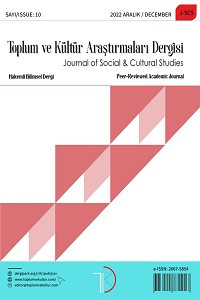Abstract
İslam sanatları üzerine yazan modern düşünür ve araştırmacıların neredeyse hemen hepsi İslam sanatlarının işlevsel olduğu konusunda hemfikirdirler. Konu üzerine yazanlara göre İslam sanatının en önemli işlevi yani Müslüman sanatçının sanat yapmaktaki amacının yegâne nedeni, metafizik âlemi, Allah’ın birliğini, izleyiciye bildirmektir. Bu iddialara göre İslam sanatları, izleyicisine felsefi/ontolojik/metafiziksel derinlikleri olan konularda ya bilgi aktarımı yapmaktadır ya da izleyicileri bu konular üzerine düşünmeye sevk etmektedir. Bu metin bu iddiaların imkânlarını hat sanatı üzerinden değerlendirmeye çalışacaktır. İslam sanatları içerisinde hat sanatının seçilme nedeni onun diğer İslam sanatlarına göre halkın günlük yaşantısı içerisinde kolayca karşılaşabilinen bir sanat olmasıdır. Hat sanatının işlevselliğini yerine getirebilmesi için en önemli şart hat kompozisyonlarının okunabilmesi ve anlaşılabilmesidir. Metin, okunabilirlik ve anlaşılabilirlik konusunu hat kompozisyonlarını teknik, fiziksel ve kültürel zorluklar açısından ele alarak değerlendirecektir. Teknik zorluklar başlığı altında hat kompozisyonlarının zamanla estetik kaygıların da eşlik etmesiyle birlikte okunabilirliklerinin oldukça zorlaştığı fikri üzerinde durulacaktır. Hat kompozisyonlarının genelde anıtsal olarak nitelendirilebilecek olan mimari yapılarda kullanılmasının onların fiziksel olarak da okunabilirliğini zorlaştırması fiziksel zorluklar başlığı altında incelenecektir. Kültürel zorluklar başlığı altında ise ana dili Arapça olmayan Müslüman toplumların hat kompozisyonlarını okuyabilme durumları çeşitli araştırmalar üzerinden karşılaştırma yapılarak değerlendirilecektir. Hat sanatının modern yorumlarda iddia edilen işlevselliği yerine getirmesinin geleneksel toplumların ve sıradan insanın tabiatı gereği mümkün olmadığı görüşü sonuç kısmında belirtilecektir.
References
- Gonzalez, V. (2020). Güzellik ve İslam İslam Sanatı ve Mimarisinde Estetik. (Çev. Muhammet Fatih Kılıç) İstanbul: Küre Yayınları.
- Dellaloğlu, F. B. (2018). Frankfurt Okulu’nda Sanat ve Toplum. İstanbul: Say Yayınları.
Abstract
Almost all modern thinkers and researchers writing on Islamic arts agree that Islamic arts are functional. According to those who wrote on the subject, the most important function of Islamic art, that is, the sole reason for the Muslim artist's purpose in making art, is to inform the viewer about the metaphysical realm, the unity of God. According to these claims, Islamic arts either convey information to their viewer on subjects with philosophical/ontological/metaphysical depths, or they prompt the viewer to think about these issues. This text will try to evaluate the possibilities of these claims through calligraphy. The reason why the art of calligraphy was chosen among the Islamic arts is that it is an art that can be easily encountered in the daily life of the people compared to other Islamic arts. The most important condition for the functionality of calligraphy is to be able to read and understand calligraphy compositions. The text will evaluate the legibility and intelligibility issues by considering the calligraphy compositions in terms of technical, physical and cultural difficulties. As it is known, the first period examples of calligraphy are compositions that are not very difficult technically. As aesthetic concerns came to the fore and compositions became complex, these compositions were almost impossible to read by non-experts. The readability of these compositions will be discussed in the technical difficulties section. Calligraphy compositions are generally located in monumental architectures as areas that can be seen by the public. However, these compositions are very difficult to read as they are on the portal, on the dome and even on the minarets. Moreover, it is quite normal in the flow of daily life that ordinary people do not have to worry about reading these stacks and thinking about their meanings. This situation of line stacks will be examined under the title of physical difficulties. Under the heading of cultural difficulties, the ability to read calligraphy compositions of Muslim societies whose mother tongue is not Arabic will be evaluated by comparing them through various studies. In this context, the result of a research on reading and understanding the Qur'an between the Faculties of Theology will be evaluated regarding the possibility of ordinary viewer to read complex calligraphy compositions. The view that it is not possible for the art of calligraphy to fulfill the functionality claimed in modern interpretations due to the nature of traditional societies and ordinary people will be stated in the conclusion part.
References
- Gonzalez, V. (2020). Güzellik ve İslam İslam Sanatı ve Mimarisinde Estetik. (Çev. Muhammet Fatih Kılıç) İstanbul: Küre Yayınları.
- Dellaloğlu, F. B. (2018). Frankfurt Okulu’nda Sanat ve Toplum. İstanbul: Say Yayınları.
Details
| Primary Language | Turkish |
|---|---|
| Journal Section | Research Articles |
| Authors | |
| Publication Date | December 30, 2022 |
| Submission Date | September 6, 2022 |
| Published in Issue | Year 2022 Issue: 10 |

